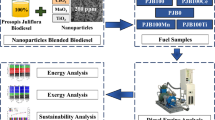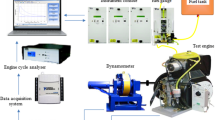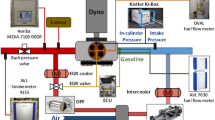Abstract
In-cylinder heat release features and nanoparticle emissions have been investigated in this study for CNG–diesel reactivity-controlled compression ignition (RCCI) engine. Study aims to determine the effect of low-temperature heat release (LTHR) and high-temperature heat release (HTHR) on the particles emissions from the RCCI engine. LTHR is obtained as a small peak (curve) before the main HTHR in the heat release rate curve. The LTHR and HTHR are not separated in heat release rate curve. The low-temperature heat release rate (LTHRR) is determined by extracting the heat release between start of combustion (SOC) to the intersection point of slope between LTHR and HTHR. The high-temperature heat release rate (HTHRR) is determined by fitting the trace between the intersection point of slope between LTHR and HTHR to the end of HTHR (the crank angle where the main HTHR turns negative after attaining the peak). This study calculates the amount of LTHR and HTHR by determining the absolute area under the LTHRR and HTHRR trajectories. Experiments are performed for different port-injected CNG masses (mc) and engine loads at a fixed engine speed of 1500 rpm. Single- and double-fuel injection strategy is used for injecting diesel. In the double-injection strategy, two cases are investigated. In the first case, diesel mass is split in the ratio of 50:50% between the first and second injection, whereas in the second case, diesel mass is divided into the proportion of 70:30%. CNG fuel mass, diesel start of injection (SOI), and the number of injections are controlled by engine electronic control unit (ECU). Results indicates that at a lower load with single-injection strategy, the lower amount of LTHR promotes the formation of small particles for 30° bTDC diesel SOI. It is found that increase in mc per cycle results in reduced and delayed LTHR and HTHR. With an increase in mc, the amount of LTHR decreases, and the total PN increases. The reduction in LTHR with an increase in mc leads to an increase in the formation of nucleation mode particles (NMPs) and a decrease in the accumulation mode particles (AMPs).



















Similar content being viewed by others
Availability of data and materials
Not applicable.
References
Agarwal AK, Singh AP, Maurya RK (2017) Evolution, challenges and path forward for low temperature combustion engines. Prog Energy Combust Sci 61:1–56
Agarwal AK, Singh AP, Kumar V (2021a) Particulate characteristics of low-temperature combustion (PCCI and RCCI) strategies in single cylinder research engine for developing sustainable and cleaner transportation solution. Environ Pollut 284:117375
Agarwal AK, Singh AP, Kumar V (2021b) Reactivity controlled compression ignition engine fueled with mineral diesel and butanol at varying premixed ratios and loads. J Energy Res Technol 144(2):022304
Ansari E, Poorghasemi K, Irdmousa BK, Shahbakhti M, Naber J (2016) Efficiency and emissions mapping of a light duty diesel-natural gas engine operating in conventional diesel and RCCI modes. SAE Technical Paper 2016–01:2309
Ansari E, Shahbakhti M, Naber J (2018) Optimization of performance and operational cost for a dual mode diesel-natural gas RCCI and diesel combustion engine. Appl Energy 231:549–561
Benajes J, García A, Monsalve-Serrano J, Boronat V (2017a) An investigation on the particulate number and size distributions over the whole engine map from an optimized combustion strategy combining RCCI and dual-fuel diesel-gasoline. Energy Convers Manag 140:98–108
Benajes J, Garcia A, Monsalve-Serrano J, Boronat V (2017b) Particulates size distribution of reactivity controlled compression ignition (RCCI) on a medium-duty engine fueled with diesel and gasoline at different engine speeds. SAE Int J Engines 10(5):2382–2391
Benajes J, García A, Monsalve-Serrano J, Villalta D (2018) Exploring the limits of the reactivity controlled compression ignition combustion concept in a light-duty diesel engine and the influence of the direct-injected fuel properties. Energy Convers Manag 157:277–287
Cambustion Ltd. (2015) DMS 500 user manual, version 4.04
Colasanti T, Fiorito S, Alessandri C, Serafino A, Andreola F, Barbati C, Morello F, Alfè M, Di Blasio G, Gargiulo V, Vomero M (2018) Diesel exhaust particles induce autophagy and citrullination in normal human bronchial epithelial cells. Cell Death Dis 9(11):1–15
Curran SJ, Hanson RM, Wagner RM (2012) Reactivity controlled compression ignition combustion on a multi-cylinder light-duty diesel engine. Int J Engine Res 13(3):216–225
Dahodwala M, Joshi S, Koehler EW, Franke M (2014) Investigation of diesel and CNG combustion in a dual fuel regime and as an enabler to achieve RCCI combustion (No. 2014-01-1308). SAE Technical Paper
Dahodwala M, Joshi S, Koehler E, Franke M, Tomazic D (2015) Experimental and computational analysis of diesel-natural gas RCCI combustion in heavy-duty engines (No. 2015-01-0849). SAE Technical Paper
Dec JE (2009) Advanced compression-ignition engines—understanding the in-cylinder processes. Proc Combust Inst 32(2):2727–2742
Dempsey A, Curran S, Storey J, Eibl M, Pihl J, Prikhodko V, Wagner R, Parks J (2014). Particulate matter characterization of reactivity controlled compression ignition (RCCI) on a light duty engine (No. 2014-01-1596). SAE Technical Paper
Dempsey AB, Walker NR, Reitz R (2013) Effect of piston bowl geometry on dual fuel reactivity controlled compression ignition (RCCI) in a light-duty engine operated with gasoline/diesel and methanol/diesel. SAE Int J Engines 6(1):78–100
Doosje E, Willems F, Baert R (2014). Experimental demonstration of RCCI in heavy-duty engines using diesel and natural gas (No. 2014-01-1318). SAE Technical Paper
Ebrahimi M, Najafi M, Jazayeri SA, Mohammadzadeh AR (2018) A detail simulation of reactivity controlled compression ignition combustion strategy in a heavy-duty diesel engine run on natural gas/diesel fuel. Int J Engine Res 19(7):774–789
Fang W, Kittelson DB, Northrop WF (2015) Optimization of reactivity-controlled compression ignition combustion fueled with diesel and hydrous ethanol using response surface methodology. Fuel 160:446–457
Gatowski JA, Balles EN, Chun KM, Nelson FE, Ekchian JA, Heywood JB (1984) Heat release analysis of engine pressure data. SAE Trans 93:961–977
Han W, Lu Y, Jin C, Tian X, Peng Y, Pan S, Liu H, Zhang P, Zhong Y (2020) Study on influencing factors of particle emissions from a RCCI engine with variation of premixing ratio and total cycle energy. Energy 202:117707
Han W, Fan Z, Jin C, Tang G, Lu Y, Pan S, Zhong Y, Liu H (2021) Study on effects of molecule structure on exhaust emissions from RCCI engine fueled with low alcohol isomers. Fuel 304:121339
Hanson RM, Kokjohn SL, Splitter DA, Reitz RD (2010) An experimental investigation of fuel reactivity controlled PCCI combustion in a heavy-duty engine. SAE Int J Engines 3(1):700–716
Heidarabadi S, Khoshbakhti Saray R, Neshat E (2021) Detailed kinetic study on methane/diesel RCCI combustion. Int J Engine Res 22(8):2422–2441
Imtenan S, Varman M, Masjuki HH, Kalam MA, Sajjad H, Arbab MI, Rizwanul Fattah IM (2014) Impact of low temperature combustion attaining strategies on diesel engine emissions for diesel and biodiesels: a review. Energy Convers Manag 80:329–356
Inagaki K, Fuyuto T, Nishikawa K, Nakakita K, Sakata I (2006) Dual-Fuel PCI combustion controlled by in-cylinder stratification of ignitability. SAE Technical Paper Series
Jia Z, Denbratt I (2015) Experimental investigation of natural gas-diesel dual-fuel RCCI in a heavy-duty engine. SAE Int J Engines 8(2):797–807
Jia Z, Denbratt I (2018) Experimental investigation into the combustion characteristics of a methanol-Diesel heavy duty engine operated in RCCI mode. Fuel 226:745–753
Kanda T, Hakozaki T, Uchimoto T, Hatano J, Kitayama N, Sono H (2005) PCCI operation with early injection of conventional diesel fuel. SAE Trans 114:584–593
Khatamnejad H, Khalilarya S, Jafarmadar S, Mirsalim M, Dahodwala M (2017). Influence of blend ratio and injection parameters on combustion and emissions characteristics of natural gas-diesel RCCI engine (No. 2017-24-0083). SAE Technical Paper
Kokjohn SL, Hanson RM, Splitter DA, Reitz RD (2009) Experiments and modeling of dual-fuel HCCI and PCCI combustion using in-cylinder fuel blending. SAE Int J Engines 2(2):24–39
Kokjohn SL, Hanson RM, Splitter DA, Reitz RD (2011) Fuel reactivity-controlled compression ignition (RCCI): A pathway to controlled high-efficiency clean combustion. Int J Engine Res 12(3):209–226
Kokjohn SL, Reitz RD (2013) Reactivity controlled compression ignition and conventional diesel combustion: a comparison of methods to meet light-duty NOx and fuel economy targets. Int J Engine Res 14(5):452–468
Maurya RK (2018) Characteristics and control of low temperature combustion engines: employing gasoline, ethanol and methanol. Springer. ISBN 978-3-319-68508-3
Maurya RK (2019) Reciprocating engine combustion diagnostics: in-cylinder pressure measurement and analysis. Springer. ISBN 978-3-030-11954-6
Maurya RK, Agarwal AK (2011) Experimental investigation on the effect of intake air temperature and air–fuel ratio on cycle-to-cycle variations of HCCI combustion and performance parameters. Appl Energy 88(4):1153–1163
Montajir RM, Kawai T, Goto Y, Odaka M (2005). Thermal conditioning of exhaust gas: potential for stabilizing diesel nano-particles (No. 2005-01-0187). SAE Technical Paper
Nieman DE, Dempsey AB, Reitz RD (2012) Heavy-duty RCCI operation using natural gas and diesel. SAE Int J Engines 5(2):270–285
Pan S, Liu X, Cai K, Li X, Han W, Li B (2020) Experimental study on combustion and emission characteristics of iso-butanol/diesel and gasoline/diesel RCCI in a heavy-duty engine under low loads. Fuel 261:116434
Park SH, Yoon SH (2016) Effect of dual-fuel combustion strategies on combustion and emission characteristics in reactivity controlled compression ignition (RCCI) engine. Fuel 181:310–318
Paykani A, Garcia A, Shahbakhti M, Rahnama P, Reitz RD (2021) Reactivity controlled compression ignition engine: pathways towards commercial viability. Appl Energy 282:116174. https://doi.org/10.1016/j.apenergy.2020.116174
Paykani A, Kakaee A-H, Rahnama P, Reitz RD (2015) Progress and recent trends in reactivity-controlled compression ignition engines. Int J Engine Res 17(5):481–524
Premnath V, Zavala B, Khalek I, Eakle S, Henry C (2021) Detailed characterization of particle emissions from advanced internal combustion engines (No. 2021-01-0620). SAE Technical Paper
Poorghasemi K, Saray RK, Ansari E, Irdmousa BK, Shahbakhti M, Naber JD (2017) Effect of diesel injection strategies on natural gas/diesel RCCI combustion characteristics in a light duty diesel engine. Appl Energy 199:430–446
Qian Y, Zhang Y, Wang X, Lu X (2017) Particulate matter emission characteristics of a reactivity controlled compression ignition engine fueled with biogas/diesel dual fuel. J Aerosol Sci 113:166–177
Qian Y, Li Z, Yu L, Wang X, Lu X (2019) Review of the state-of-the-art of particulate matter emissions from modern gasoline fueled engines. Appl Energy 238:1269–1298
Reitz RD (2013) Directions in internal combustion engine research. Combust Flame 160(1):1–8
Reitz RD, Duraisamy G (2015) Review of high efficiency and clean reactivity controlled compression ignition (RCCI) combustion in internal combustion engines. Prog Energy Combust Sci 46:12–71
Ristovski ZD, Miljevic B, Surawski NC, Morawska L, Fong KM, Goh F, Yang IA (2012) Respiratory health effects of diesel particulate matter. Respirology 17(2):201–212
Ryan Walker N, Wissink ML, DelVescovo DA, Reitz RD (2015) Natural gas for high load dual-fuel reactivity controlled compression ignition in heavy-duty engines. J Energy Resour Technol 137(4):042202
Saxena MR, Maurya RK (2018a) Effect of fuel injection strategy on nano-particle emissions from RCCI engine (No. 2018a-01-1709). SAE Technical Paper
Saxena MR, Maurya RK (2018b) Effect of diesel injection timing on peak pressure rise rate and combustion stability in RCCI engine (No. 2018b-01-1731). SAE Technical Paper
Saxena MR, Maurya RK (2020a) Experimental investigation of combustion stability and particle emission from CNG/diesel RCCI engine (No. 2020a-01-0810). SAE Technical Paper
Saxena MR, Maurya RK (2020b) Influence of direct injection timing and mass of port injected gasoline on unregulated and nano-particle emissions from RCCI engine. Fuel 282:118815
Saxena S, Bedoya ID (2013) Fundamental phenomena affecting low temperature combustion and HCCI engines, high load limits and strategies for extending these limits. Prog Energy Combust Sci 39(5):457–488
Shibata G, Oyama K, Urushihara T, Nakano T (2004) The effect of fuel properties on low and high temperature heat release and resulting performance of an HCCI engine (No. 2004-01-0553). SAE Technical Paper
Shibata G, Oyama K, Urushihara T, Nakano T (2005) Correlation of low temperature heat release with fuel composition and HCCI engine combustion (No. 2005-01-0138). SAE Technical Paper.
Singh AP, Kumar V, Agarwal AK (2021a) Evaluation of reactivity controlled compression ignition mode combustion engine using mineral diesel/gasoline fuel pair. Fuel 301:120986
Singh AP, Sharma N, Kumar V, Agarwal AK (2021b) Experimental investigations of mineral diesel/methanol-fueled reactivity controlled compression ignition engine operated at variable engine loads and premixed ratios. Int J Engine Res 22(7):2375–2389
Singh AP, Sharma N, Satsangi DP, Agarwal AK (2020) Effect of fuel injection pressure and premixed ratio on mineral diesel-methanol fueled reactivity controlled compression ignition mode combustion engine. J Energy Res Technol 142(12):122301
Splitter D, Wissink M, DelVescovo D, Reitz RD (2013) RCCI engine operation towards 60% thermal efficiency. SAE Technical Paper Series
Storey JM, Curran SJ, Lewis SA, Barone TL, Dempsey AB, Moses-DeBusk M, Hanson RM, Prikhodko VY, Northrop WF (2017) Evolution and current understanding of physicochemical characterization of particulate matter from reactivity controlled compression ignition combustion on a multicylinder light-duty engine. Int J Engine Res 18(5–6):505–519
Tong L, Wang H, Zheng Z, Reitz R, Yao M (2016) Experimental study of RCCI combustion and load extension in a compression ignition engine fuelled with gasoline and PODE. Fuel 181:878–886
Yao M, Zheng Z, Liu H (2009) Progress and recent trends in homogeneous charge compression ignition (HCCI) engines. Prog Energy Combust Sci 35(5):398–437
Zhang Y, Ghandhi J, Rothamer D (2014) Comparison of particulate size distributions from advanced and conventional combustion-part I: CDC, HCCI, and RCCI. SAE Int J Engines 7(2):820–834
Zou X, Wang H, Zheng Z, Reitz R, Yao M (2016). Numerical study of the RCCI combustion processes fuelled with methanol, ethanol, n-butanol and diesel (No. 2016-01-0777). SAE Technical Paper.
Acknowledgements
Financial support of CSIR through SRA under Scientists Pool Scheme to Dr. Mohit Raj Saxena is gratefully acknowledged. This support enables his stay for working in Advanced Engine and Fuel Research Laboratory, Department of Mechanical Engineering, IIT Ropar, India. The authors gratefully acknowledge the research funding provided by DST-SERB, Government of India, through Project No. CRG/2020/005381 titled “Experimental investigation of toxicity and mutagenicity of particulates, and combustion stability in conventional as well as advanced high- efficiency reciprocating engines using different alternative fuels”.
Funding
The authors gratefully acknowledge the research funding provided by DST-SERB, Government of India through Project No. CRG/2020/005381 titled “Experimental investigation of toxicity and mutagenicity of particulates, and combustion stability in conventional as well as advanced high-efficiency reciprocating engines using different alternative fuels”.
Author information
Authors and Affiliations
Contributions
Roles and responsibilities of authors are as follows: MRS contributed to methodology, data curation, investigation, and writing—original draft preparation. SR was involved in methodology, data curation, investigation, and writing—original draft preparation. RKM contributed to conceptualization, visualization, writing—review and editing, and supervision. All authors read and approved the final manuscript.
Corresponding author
Ethics declarations
Conflict of interests
The authors declare that they have no competing interests.
Ethics approval and consent to participate
Not applicable.
Consent for publication
Not applicable.
Additional information
Editorial responsibility: Chenxi Li.
Rights and permissions
Springer Nature or its licensor (e.g. a society or other partner) holds exclusive rights to this article under a publishing agreement with the author(s) or other rightsholder(s); author self-archiving of the accepted manuscript version of this article is solely governed by the terms of such publishing agreement and applicable law.
About this article
Cite this article
Saxena, M.R., Rana, S. & Maurya, R.K. Experimental investigation on the effect of in-cylinder heat release features on particle emissions characteristics of CNG–diesel RCCI engine. Int. J. Environ. Sci. Technol. 20, 13433–13452 (2023). https://doi.org/10.1007/s13762-023-04811-1
Received:
Revised:
Accepted:
Published:
Issue Date:
DOI: https://doi.org/10.1007/s13762-023-04811-1




